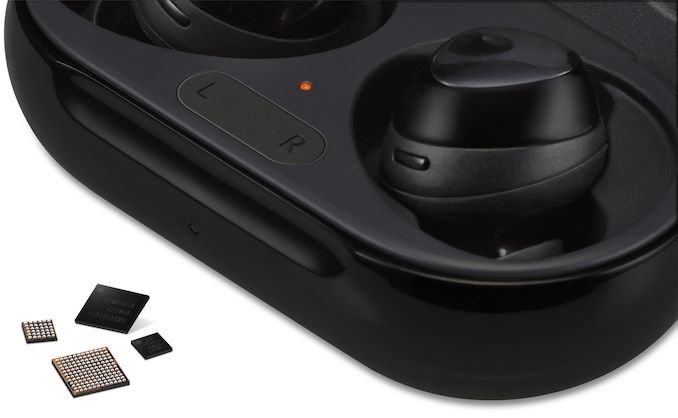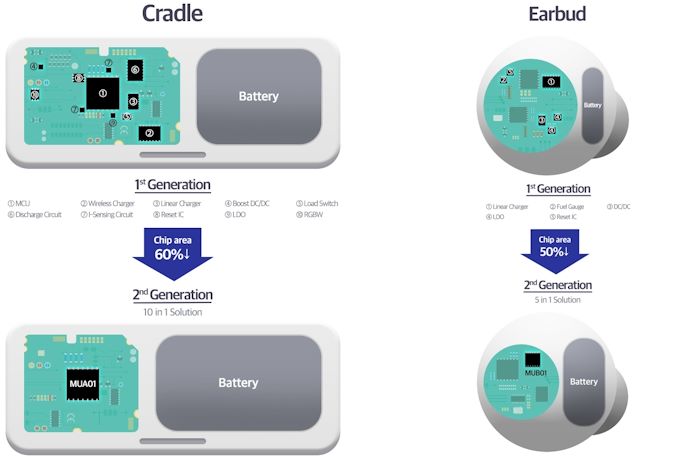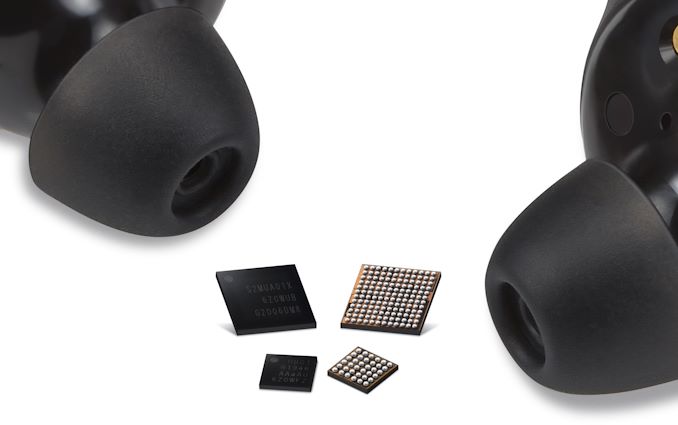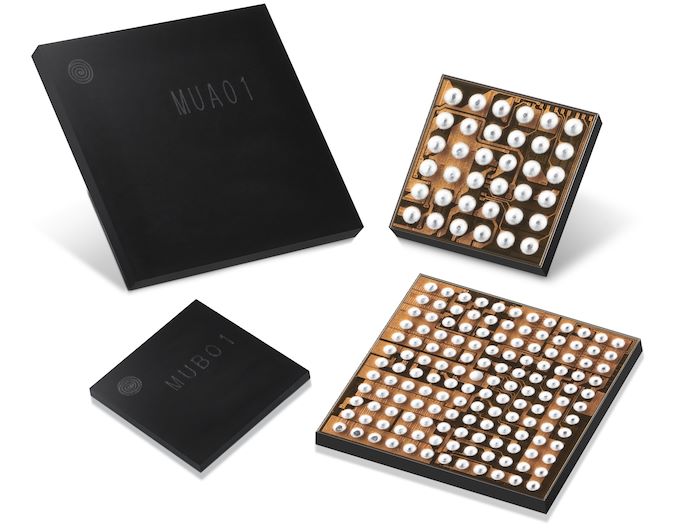Samsung Reveals All-in-One Power Management ICs for Wireless Earbuds
by Anton Shilov on March 24, 2020 5:00 PM EST- Posted in
- Peripherals
- Samsung
- Galaxy
- Earbuds
- Galaxy Buds

Samsung has formally announced two new all-in-one power management integrated circuits (PMIC) developed specifically for "True Wireless Stereo" (TWS) devices (a.k.a. earbuds). The highly integrated PMICs are being touted as allowing earbuds to be built with longer battery lives and better ergonomics. And because this is Samsung, the the first earbuds to use the new PMICs are fittingly Samsung’s own Galaxy Buds+.
Samsung’s family of PMICs for TWS devices includes the MUA01 designed for charging cases, as well as the MUB01 for the earbuds themselves. Previously, power management solutions for earbuds have used 5 to 10 discrete components (see the image below), including switching chargers and discharge circuits, which take precious space. Samsung says that it has managed to integrate all of these components into one chip, occupying half the space as before, which enables it to save space inside earbuds and charging cases. Ultimately, the goal is to free up space in earbuds to integrate higher-capacity batteries, better speakers, and refine ergonomics.
The MUA01 supports both wired as well as wireless charging (and happens to be the industry’s first solution of this kind to support both) and is compatible with the latest Wireless Power Consortium’s Qi 1.2.4 specification. Like other devices of this kind, the MUA01 integrates a microcontroller unit (MCU) with eFlash to enable firmware upgrades. Furthermore, both MUA01 and MUB01 support power line communication (PLC) technology that enables earpices and charging cases to share essential information, such as battery levels.
Samsung has already started to mass produce its MUA01 and MUB01 PMICs and uses them inside its recently announced Galaxy Buds+ that are rated for up to 11 hours of operation on one charge.
Related Reading:
- Samsung Galaxy S20 Ultra (Snapdragon 865) Quick Performance Preview: Impressive
- Samsung Galaxy S20+ & Ultra (Snapdragon & Exynos) Battery Life Preview
- Samsung Announces The Galaxy Z Flip: Foldable Phone With Glass
- Samsung Announces The Galaxy S20, S20+ and S20 Ultra: 120Hz, 5G, Huge Batteries, Crazy Cameras and $$$
- Samsung's Unpacked 2020 Event: Galaxy S20 And More - Live Blog (11am PT)
Source: Samsung













9 Comments
View All Comments
willis936 - Tuesday, March 24, 2020 - link
Wireless earbuds have a lot of potential. This looks like a starting point, but I wish things would move faster. ANC is the obvious next feature to add, but there are features that could be implemented at a mediocre cost and massive benefit.EQs that could flatten the magnitude response.
Allpass filters (or FIR if delay is acceptable) could minimize group delay.
Microphones could be used to adaptively update the filter values.
These techniques have been used in telecommunications for decades, but audio has been “good enough” for longer, so these features have remained barred behind absurd costs and the implementations have decayed into trash. I see wireless earbuds as a platform that could lead to proper audiophile quality for all. The parts are cheap and the engineering is easy. The only showstopper is not having a market...
lmcd - Tuesday, March 24, 2020 - link
This is one of those areas where it's hard for me to understand why we'd change.These devices make so many tradeoffs for mild improvement in utility.I know I'm not the target audience, but I don't get how someone would pay so much for these audio products and not pay close enough attention to audio quality/fidelity to notice the downsides. To me, they seem like a stylish, stereo Jabra.
wr3zzz - Wednesday, March 25, 2020 - link
The target demo for expensive earbuds are either people with too much money, or people who are financially irresponsible. The battery will last two years before planned obsolescence kicks in.Retycint - Wednesday, March 25, 2020 - link
Guess what, consumers are willing to pay for convenience. I don't think that's a very foreign concept. Anyway the audio quality of wireless earbuds have been good enough for the average consumer already. Not everyone is an audiophile who listens to FLACs, you knowBedfordTim - Wednesday, March 25, 2020 - link
I got a free set of Nokia buds and while the sound quality was adequate the battery life was terrible. I might use them again in summer as they are cooler than over ear phones but was definitely underwhelmed. I haven't tried them running as I always leave my phone behind.Eliadbu - Saturday, March 28, 2020 - link
we've changed since companies kinda forced us to. it started with Apple creating a problem (removing the headphone jack) and then solving it for us with a solution that conveniently making them more money. other solution were far less preferable by most people like having dongles that have their own downsides. most people adapted to buy the given solution and just turned their face to the other way when facing the clear disadvantages. other companies just followed suit seeing the economical benefits of creating those "solutions" .olafgarten - Wednesday, March 25, 2020 - link
I can't use these true wireless earbuds, I'm the only person I know who can notice, but the sound between the two channels isn't always synchronised and it is really offputting.Adi_Nemesis - Wednesday, March 25, 2020 - link
I highly recommend you try our any of the Apple Airpods.The H1 Chip inside them takes care of synchronization. Most, if not all, True Wireless Earbuds have a relay system, the device (like your smartphone) transmits audio to one earbud, which then relays the signal to the other.
In Apple's Airpods, both the earpieces receive the signal directly from the device.
wr3zzz - Thursday, March 26, 2020 - link
Apple has a patent of how to sync the audio between two buds that are no physically connected. First gen of Android chips had to get around the patent and they weren't good. The second gen that came out near the end of 2019 supposedly are as good as Apple's as far as syncing.